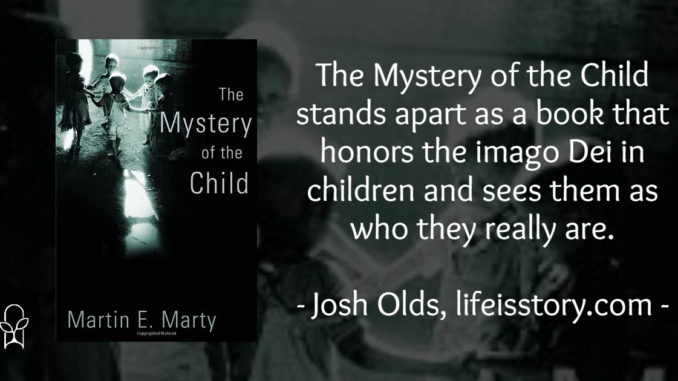
Published by Eerdmans on October 10, 2022
Genres: Academic, Non-Fiction, Parenting
Buy on Amazon
Goodreads

Much of today's writing on children treats the child of any age as a problem or a set of problems to be solved, effectively reducing the child to a complex of biological and chemical factors, explainable in scientific terms, or regarding children as objects of adult control. In contrast, Martin Marty here presents the child as a mystery who invokes wonder and elicits creative responses that affect the care provided him or her.
Drawing on literature as new as contemporary poetry and as old as the Bible, The Mystery of the Child encourages the thoughtful enjoyment of children instead of the imposition of adult will and control. Indeed, Marty treats the impulse to control as a problem and highlights qualities associated with children -- responsiveness, receptivity, openness to wonder -- that can become sources of renewal for adults.
The Mystery of the Child represents a new tack for Martin Marty -- universally respected as a historian, theologian, and interpreter of religion and culture -- but displays the same incisive, erudite quality marking the fifty-plus books and thousands of articles that he has previously written. Marty's broad, thoughtful perspective will inspire readers to think afresh about what it means to be a child -- and to be a caregiver.
This book is sure to claim a wide readership -- parents, grandparents, schoolteachers, theologians, historians -- engaging anyone wanting to explore more fully the profound realm of the child.
When I first posted a photo on social media of myself reading Martin Marty’s The Mystery of the Child, the response was predictable: “Let me know when you figure it out!” But the whole premise of Marty’s book is something entirely different. Mystery isn’t something to be solved, it’s something to celebrate. Marty’s central premise is that, all too often, adults see children as a problem to be solved rather than a mystery to explore and celebrate. The result is that adults attempt to exert control over children, making child-rearing a fight rather than a collaboration that stifles children’s independence, artistry, and creativity.
Marty’s premise is couched in prose that is as mystical as it is academic. He can be difficult to follow at times and a good portion of his book is spent in dialogue with other works. While one doesn’t necessarily need to have read those works to follow Marty’s line of thinking, it certainly would be a benefit. From a layman’s perspective, I also think the book could have benefited from tighter editing. It may simply be the style the series is going for, but I did feel that some sections of the book felt not quite integral to Marty’s argument or a retread of things already established. However, exhaustiveness to the point of exhaustion is sometimes the point of academia.
My biggest takeaways from The Mystery of the Child are the value of play and the necessity of perceiving children as people made in the image of God—not objects to control. Either of these are groundbreaking in their own right. When you consider our current educational models, ones based on sitting in desks and conforming to curriculum, The Mystery of the Child offers a radically different view of childhood development. Marty’s premise demands sincere and deep consideration. While focusing on control may make the problem of parenting (or teaching or coaching, etc etc.) easier, it may not actually develop children to their healthiest and fullest potential.
I do wish that there had been more practicalities in the book, discussing what understanding the child as mystery leads to practically, at what point does the need for discipline require control, how can we change the narrative of control in our teaching systems, and so forth. Regardless, just in terms of its radically reforming orientation, The Mystery of the Child stands apart as a book that honors the imago Dei in children and sees them as who they really are. As Marty concludes:
“In the presence of adults who would like to control her, one asks: Explain the mysterious child? No, let her dance.” – p. 69
